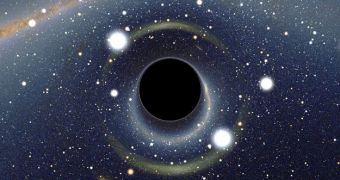Astrophysicists have known for a long time that at the core of every massive galaxy lies a very large black hole that feeds on the matter there. The black holes are known to create features named accretion disks, which are heated to millions of degrees and represent the final resting place of regular matter before it passes the event horizon. The massive gravitational pull of black holes is known to keep galaxies in place and spinning, but now astronomers say that binary systems are not an uncommon occurrence. Recent observations have identified about 33 such black hole pairs in distant galaxies, Space reports.
Theoretical predictions have shown astronomers that such structures must exist in the Universe. However, only a small number of the binary systems have been directly observed until now. The recent set of studies shows that the formations exist in larger numbers, or at least did so in the early Universe. The results “show that dual supermassive black hole systems are much more common than previously known from observations,” University of California in Berkeley (UCB) astrophysicist and researcher Julia Comerford explained. She presented the findings yesterday in Washington DC, at the 215th meeting of the American Astronomical Society (AAS).
The team also reported that many of the new binary black hole systems were found using the ten-meter (400-inch) Keck II Telescope, which is located atop Mauna Kea, in Hawaii. The team here used the Deep Imaging Multi-Object Spectrograph instrument on the famous observatory to conduct the DEEP2 Galaxy Redshift Survey, which is a study of more than 50,000 galaxies spread across the night sky. At this point, the researchers believe that the best explanation for the formation of black hole pairs lies in galactic mergers.
As two massive galaxies collide and merge with each other, the black holes they contain at their cores spiral towards the center of the newly formed space structure and then start orbiting each other. This will probably happen when the Milky Way collides with Andromeda as well. It was also demonstrated in the new research that each of the distant galaxies surveyed collided with another one about three times per one billion years. “This merger rate is in agreement with other methods. The important thing about using these to estimate the merger rate is it's a completely independent means,” Comerford concluded.

 14 DAY TRIAL //
14 DAY TRIAL //